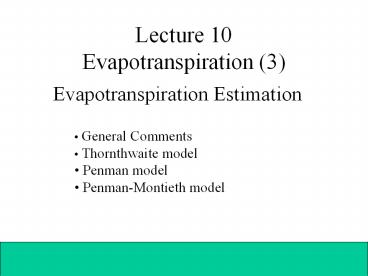Lecture 10 Evapotranspiration (3) - PowerPoint PPT Presentation
Title:
Lecture 10 Evapotranspiration (3)
Description:
Lecture 10 Evapotranspiration (3) Evapotranspiration Estimation General Comments Thornthwaite model Penman model Penman-Montieth model General Comments Thornthwaite ... – PowerPoint PPT presentation
Number of Views:183
Avg rating:3.0/5.0
Title: Lecture 10 Evapotranspiration (3)
1
Lecture 10 Evapotranspiration (3)
Evapotranspiration Estimation
- General Comments
- Thornthwaite model
- Penman model
- Penman-Montieth model
2
General Comments
- ET is the basic hydrological components needed
for many purposes - ET is affected by many factors, and formulae
with various complexities are needed for
different applications - ET can be measured with large efforts, but can
also be modeled accurately in most cases
3
Thornthwaite Model
- Developed by Warren Thornthwaite in 1948 to
estimate PET - Generally applicable to arid areas like Central
and eastern USA
1. Begin by computing the monthly heat index
i Monthly heat index t Mean
temperature of the month
2. Sum the 12 monthly heat index into an annual
heat index (I)
I Annual heat index m Month (1
January 12 December) tm Mean temperature
for month m
4
Thornthwaite Model
3. Compute monthly potential ET
i Monthly heat index I Annual
heat index Ep Monthly potential ET
(cm) b (Total monthly daylight
hours)/360 a Cubic function of I 0.49
1.79?10-2I 7.711?10-5I2 6.751?10-7I3
5
Characteristics of theThornthwaite Model
- Purely empirical
- Used where data are limited. Relatively little
data required - Criticism for using air temperature justified
because of the fixed relationship between the
portion of Rn used for heating and that portion
used for evaporation under PET conditions (full
water availability) - An indirect reference to the radiation balance
- Model adopted for use in North America
(temperate and continental climate) Temperature
and radiation are highly correlated - Downfall over the course of a year, air
temperature tends to lag behind radiation
6
Penman Model
- Developed by Howard Penman in 1948 (later
modified by John Monteith et al. to yield the
PenmanMonteith model) - Much greater demands on data than the
Thornthwaite model - Well established and a basis for further
theoretical development in the field of
evaporation research - Basically a combination of turbulent transfer
and energy-balance approaches (3 equations)
7
Penman Model
1. Equation 1 for the drying power of the air
Ea Potential evaporation ea
Saturation vapor pressure ed Saturation
vapor pressure at dew point u Wind speed
(miles/day _at_ 2 m height)
8
Penman Model
2. Equation 2 for the available energy for latent
heat and heating the surface
H Available net radiation (Rn) r Albedo of
evaporating surface Ra Theoretical radiation
intensity (no atmosphere) n/N Ratio of actual
to possible sunshine hours ? Stefan Boltzman
constant 5.67?10-8 W m-2 K-4 or 1.38?10-12 cal
cm-2 s-1 K-4 Ta Mean air temperature (?K) ed
Saturation vapor pressure at dew point
9
Penman Model
3. Equation 3 for computing the actual ET (Penman
Equation)
? Rate of change of es with temperature ?
Psychrometric constant 0.66 mb/?C E Actual ET
10
Characteristics of Penman Model
- Originally designed for evaporative computations
from free water surfaces (Eo) - Can be related to extensive, short, green
vegetated surfaces by multiplying by a constant - ET f ? Eo
- where, f averages 0.75, but is influenced by
seasons etc. - Various modifications and substitutions of this
base model are possible - Heat conduction in soil is ignored
11
Penman-Monteith Model
- The Penman model does not consider surface
resistances or atmospheric resistances - John Monteith et al. modified the Penman
equation to perhaps its most popular format to
incorporate these resistances - The model considers the vegetation canopy as one
isothermal leaf (not a set of individual leaves)
12
Penman Monteith Equation
? Density of the air c Specific heat of the
air ea Saturation vapor pressure at mean air
temperature ed Saturation vapor pressure at dew
point rs Total surface resistance ra Aerodynam
ic resistance l ? Latent heat
of vaporization ? Psychrometric
constant ? Rate of change of es with
temperature
13
Characteristics of Penman-Monteith Model
- Due to data requirements, the model is used more
widely in conceptual ways rather than in
physically determining potential
evapotranspiration - Big leaf model is geared towards homogeneous
canopies - Considers a bulk canopy conductance equal to the
parallel sum of the individual leaf stomatal
conductances - Various authors have compared these techniques,
indicating the superiority of the Penman-Monteith
model as a comparison, the Thornthwaite model
tends to underestimate potential
evapotranspiration































